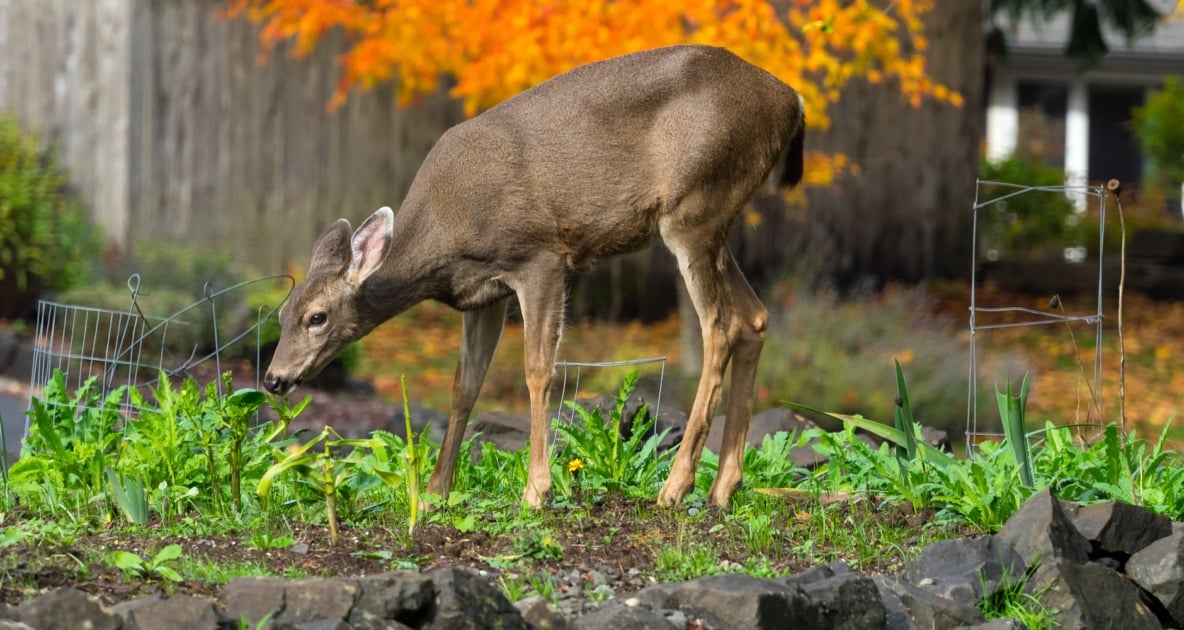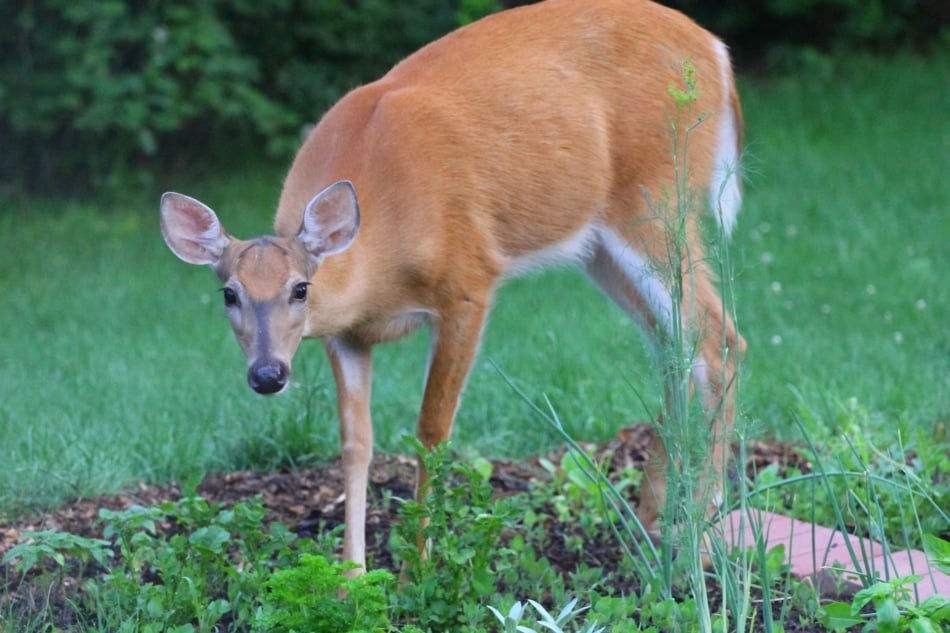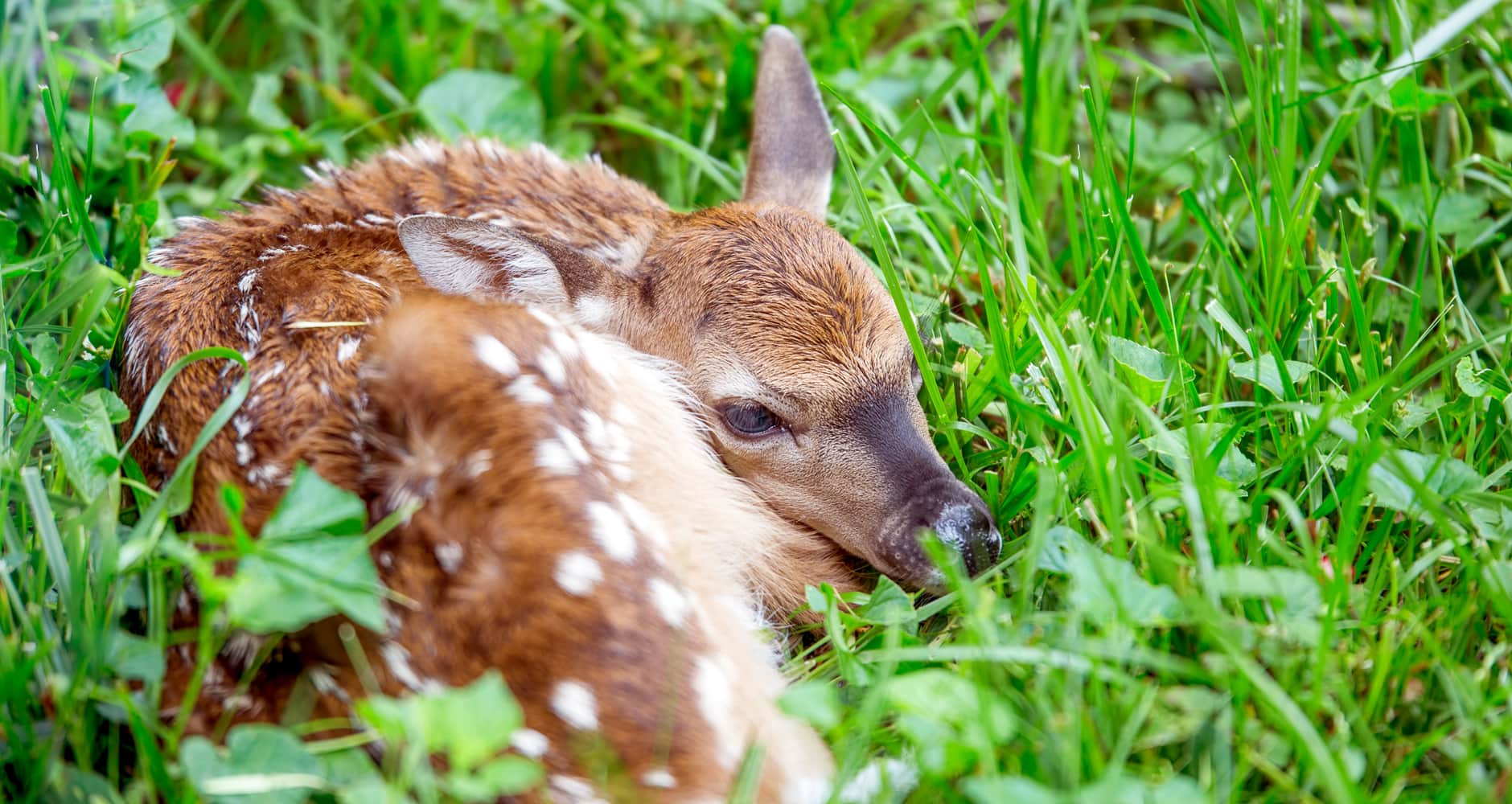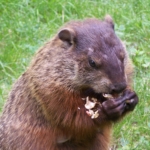Surefire Ways To Keep Deer Out of Your Garden
White-tailed deer are beautiful, but destructive. Keep them from turning your garden into a salad bar!

Wild animals are part of what makes nature so magical, and watching them can be highly enjoyable. While it’s important to coexist with animals in relative peace, they can cause countless problems when they take up residence in our homes or gardens. In this series, our Wildlife Management Specialist, Shawn Weeks, will educate us about some common household pests, and share some strategies for keeping them under control without dangerous chemicals or poisons.
We’ll look at Odocoileus virginianus, better known as the white-tailed deer.
Habitat and History
White-tailed deer are found throughout North America. The only US states where they are not widespread are Alaska, Utah, Nevada, and California. Adult males weigh around of 150 pounds, with females averaging 110 pounds. They are graceful animals with conspicuous ears, narrow, pointed hooves, and long legs. Adult males have seasonal antlers, which begin to grow in spring with a “velvet” cover. The velvet is actually a soft and sensitive tissue. During the fall, the deer antlers begin to get hard and the deer scrape the velvet off on trees and saplings. They then use their antlers to spar with other males during the rut, or mating season. The antlers are then shed in early to mid-winter. Antler size is determined by their genetics, age, and diet.
White-tailed deer have a coat of hair that is reddish-brown to tan in summer with short, thin hairs. In winter, it turns grayish-brown to gray and fills out with thick, long hairs. As the name implies, white-tailed deer have a bright white patch of fur on the underside of their tails. If they are scared, they raise their tails high, like a white flag, as they run away.
These deer do well in woodland forests with a vegetative understory, as well as in fields and meadows that are left to grow tall. Their favorite habitat however, is edge. Edge is the area between forests and fields. This is a major reason deer thrive in suburban areas where large yards border small woodlots.
Diet
The diet of white-tailed deer varies depending on the seasons. During the spring and summer, deer eat grasses and forbs, which contain protein. During the fall, deer focus their attention on acorns and other mast items. This mast diet is full of fat and carbs that the deer need to fatten up for the colder months, and the rut. During the winter, deer eat twigs and buds from different hardwood trees and leaves from conifers such as white pine and hemlock.
Reproduction
The mating season, also known as the rut, starts at different times, depending on where the deer live. In the northern part of the United States, rut begins around late October and extends through early January. Fawns are usually born in late June. In other areas, the rut may occur earlier or later, depending on the climate. Newborn fawns generally weigh between four and eight pounds. They are dependent on their mothers until, and sometimes through, September when they are weaned. The doe, or female, usually has one to four fawns, depending on her age and general health. Twins are not an uncommon occurrence.
Problems, Solutions and Health Concerns
One method for managing white-tailed deer on your property is hunting if it is safe and legally acceptable to do so where you live. If hunting is not an option for you, whether because it goes against your principles or because you live in an area where it is prohibited, you can use other methods to protect your crops and vegetation.
Keeping Deer Away From Your Garden

Perhaps the most effective way of keeping deer off your property is with a deer fence. Deer fences are easy to install, although they can be rather costly, especially if you own a lot of land. In my wildlife management practice, I have installed literally miles of deer fencing with great success for my clients. Generally, it is installed around the perimeter of a property. Gates can be installed in specific locations where the customer wants access to certain areas of the property. Deer fencing should be at least eight feet high to be effective. White-tailed deer have been known to jump as high as six to seven feet on a full run. Most deer fencing is black polypropylene mesh, which blends in well with forested landscapes. It should be inspected regularly for damage.
One could also install electric, high tensile wire fencing. This type of fencing can work well for protecting one’s crops from deer browse. Another solution for property owners would be to fence around individual bushes, islands, and vegetation that you want to be protected. With this method, it’s not necessary to use such a tall fence. Shorter chicken wire fencing is sufficient for this application.
There are also numerous commercial repellents on the market today. Some of these repellents work very well. However, they should be thought of as a maintenance application. They will all need to be reapplied after every rain shower or heavy dew. You can also use homemade repellents. Some effective homemade repellents to try to include human hair tied in mesh sacks around the plants you want to protect, bone meal, soap shavings, and liquid hot pepper spray. Try this deer repellent.
A number of other preventive measures can also be effective. Planting away from hedgerows or tree lines could help. Planting ornamentals that deer do not like can also have a positive effect. These include columbine, coneflower, goatsbeard, St. John’s Wort, meadowsweet, sea holly, marjoram, peonies, trillium, foxglove, lavender, verbena, and many others. However, many plants that were once unpalatable to deer, such as boxwood, holly, and rhododendron, are sometimes eaten in places where there is a large population of deer. In the state of Connecticut, for instance, an exceptionally large deer herd creates a huge amount of pressure for food. Some parts of the state have been estimated to have as many as 35 deer per square mile. However, this is not the “norm”.

Due to the fact that deer are wild animals and can be unpredictable, the most beneficial strategy is to employ a combination of methods to keep deer from harming your crops, ornamentals, and understory. Applying repellent to shrubs could be effective along your front porch, while a mesh fence around the corn behind your barn would be a necessity. Just remember that, while deer are a beautiful, stately animal, they can be extremely persistent and can cause a lot of property damage if not managed diligently.

Shawn Weeks
Shawn is a lifelong New Englander. He lives in Canton, Conn., with his wife Tami, mother, sister, and her three children. He and his wife have two grown children and two grandchildren. Shawn is an avid hunter, fisherman, and gardener. He is also a writer, a nuisance wildlife professional, small scale farmer, and scout leader. You can email him at [email protected].








I painted my aunts wood siding with a liquid dish soap. It was not a whole house though. You might have to dilute it and spray it on. Worked great.
I use scent flags. I tear up an old t-shirt and tie them to 4 foot tall stakes strategically placed along the border of my garden. I have them placed about every 20 feet or so. On the flags I typically use something that has a very strong smell such as axe body spray. This does a pretty good job of keeping the deer away as long as I keep it applied regularly. I will also put something similar to axe body wash in my insect control spray to help out too.
Does anyone have ANYTHING effective to offer on how to keep woodpeckers away from a cedar-sided home? They already have 2 holes the size of a coffee can lid on one end of my home, and cedar is very expensive right now, so replacing the boards at this time is not a solution. In my area the woodpeckers are a protected species so I cannot take my BB gun and end this nightmare. I’ve tried to lure them away from the house by placing a large birdfeeder full of shelled peanuts close by the house, and then moving it farther away every week or so (by just a couple of feet at a time) which is information I received from the City. But it hasn’t worked very well because all the other birds are gathering at the feeder and eating up the food, along with 2 of those cake things made of waxy stuff and bird feed. So, as usual, the City was no help at all. Aren’t they supposed to be the “city planners” who actually help people with problems like this?
The reason I have this problem is my neighbors. I have nicely asked them several times to please remove one of their 25 bird feeders and every time I say something to them about it, they just put up more feeders. I’m dead serious this is what they do. Sooooo, the birds eat in their yard, poop in my yard and all over my lawn furniture and outdoor grill, etc., and it lures them to the area. I do not have a bird feeder, since the last idea with the peanuts didn’t work. That was an expensive little trial and error – about $90 all told.
Does anyone have any ideas for me? I’d appreciate anything you’ve got!
Go to this site and read the suggestions. I like the big owl idea; can buy them at some garden centers, or do a search on Internet. https://www.forestwildlife.org/how-to-stop-woodpeckers-from-pecking-your-house/
Spray them with a hose or sprinkler
Actually this is a pretty good idea. They make motion activated sprinklers to help keep deer out of the garden. This may be an excellent way to keep the buggers away. The other thing I might say is an airsoft gun. It should run them off without actually harming them
My solution? A dog. She chases them away from the garden, we live on ten acres in the country and it is very effective. We love deer, but we love our garden. Our dog doesn’t hurt the deer because the deer would kick her butt, but she is a very effective deterrent.
Dog hair, and human hair… they don’t like either. I tend to brush my dog next to my garden.
I use 2 raw eggs beaten and added to 1 gal of hot water sprinkled around my garden or shrubs. They will not come near them. Won’t keep raccoons or possums out. They will come much more because they like rotten food. But no deer or rabbits.
I ment but goodness courtney but thanx for the help on the deer problem !
umm buzzsaw an 8 foot fence don’t mean anything honey I’ve tried it ok it don’t help that much believe me !
I can’t keep racoons out of my corn feild I mean they are cute an all be goodness
Plant running beans in your corn rows after the corn is about 18″ high. Racoons don’t like getting tangled up in the vines. I read this a long time ago in Mother Earth news. Never had any in my corn.
I have tried everything to keep deer out of my garden i live in defuniak springs florida the secret to keeping deer out of my garden is called REMINGTON 870 works well,
lol … Lived there briefly in the late 90’s … right off hwy 90 … My husband is good friends with the Sandlers … Do they still have that old wood shack post office … that was so cool … Debra MM
We live in the High Plains Desert of rural Central Nevada for many years and until recently did not have problems with deer. Having a neighbor across the street feeding the deer did not help. Once they arrived, we discovered that they were jumping the perimeter fence and demolishing our drawf tree orchard and grape vines. We tried several methods to “repel” deer.
We began with our 90′ x 90′ food garden, using light duty garden posts to extend the existing T-posts and wrapping fiber and nylon ropes around the garden perimeter. This method was successful in keeping the deer out, but the rope sagged from rain and wind, and started to decay from the sun.
Many factors were learned and taken into consideration such as some of the repellents just do not work, the cost of reapplying on a constant basis, the damage some of the repellents did to the trees and grapevines, the winds, the rain and sun decay of the rope, and county ordinances, we came to the decision to extend the perimeter fence T-posts with light duty garden posts every ten feet and snuggly (not tight) wrapping electrical fencing tape around the posts. The extension is about 2′ above the existing fence. The garden posts have tabs that can be closed on the tape, which is fiber and metal. The tape was given one twist before the it was carefully tapped into the tabs, so when the wind blew, it would twist the tape. The tape, also, gives off a sound when it twists. There is a limited amount of color but we went with the white tape.
We decided on the electrical fence tape because of its length in one continuous roll and the strength of it by having the metal in the tape. So far, it is working out very well. At first, the deer had problems jumping out of our yard and stopped dead in their tracks at the fence. Once in a while, we would see deer track along the outside of the perimeter fence, but no indications of jumping the fence. Now, we find no tracking at all. Once our perimeter trees have caught up and grow to the height of the tape, the posts and tape will be removed.